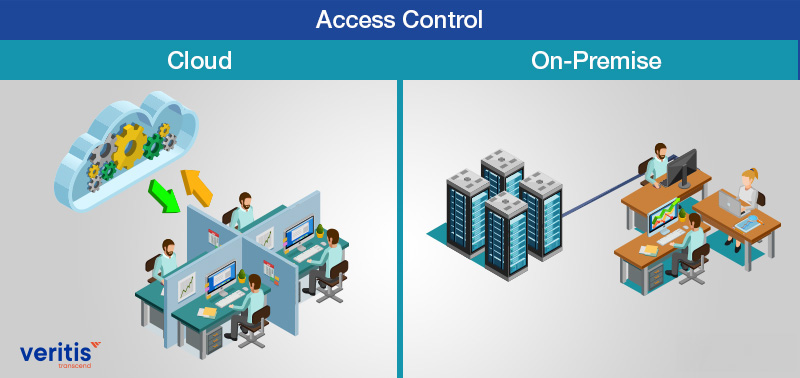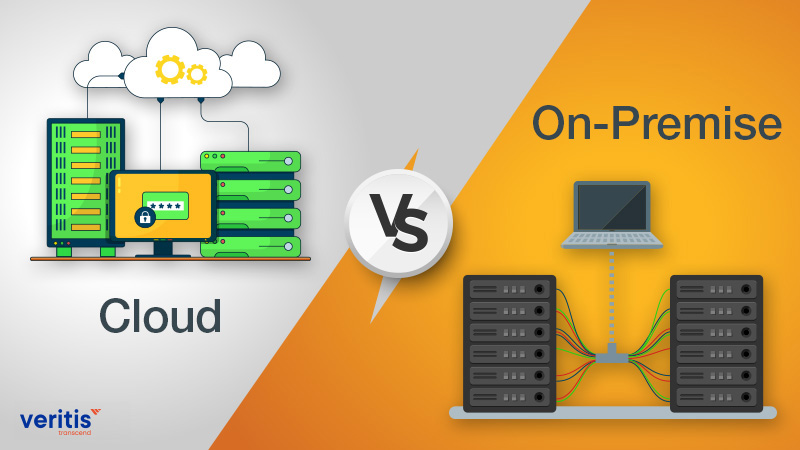
IT infrastructure has been undergoing transition over decades. The IT industry has matured to a stage where infrastructure maintenance is easily manageable from the level of traditional hardware with heavy maintenance.
Cloud based infrastructure is one solution in that journey that simplifies IT maintenance concerns by taking care of core infrastructure aspects over the network. However, Cloud solutions are not a complete answer because of the strong preferences for on-premise solutions on the other side.
The cloud vs on-premise installations are various. While cloud based infrastructure is enabled over the network, on-premise servers (as the name suggests) deal with infrastructure at organizational premises or on-site. However, both solutions aim to reduce organizational costs and maintenance burdens by implementing agile IT infrastructure services. Cloud based infrastructure has already proved to be cost-effective and more accessible for small businesses, mainly for its agile and flexible integrations at affordable costs.
Cloud computing and on-premise infrastructure are two of the most common approaches to IT infrastructure management. Recently, cloud computing has gained significant traction, with many organizations migrating their workloads to the cloud. However, on-premise infrastructure remains a viable option for some organizations.
Key Statistics
- Cloud computing market size: The global cloud computing market is expected to reach USD 480.0 billion in 2023, up from USD 332.3 billion in 2022. (Source: Statista)
- Cloud adoption: As of 2023, 83% of organizations have adopted cloud computing, and 58% have a multi-cloud strategy. (Source: Flexera 2023 State of the Cloud Report)
- On-premise infrastructure: Despite the growth of cloud computing, on-premise infrastructure is still widely used. 27% of organizations plan to increase their investment in on-premise infrastructure in 2023. (Source: IDC 2023 IT Infrastructure Spending Guide)
Benefits of Cloud Computing
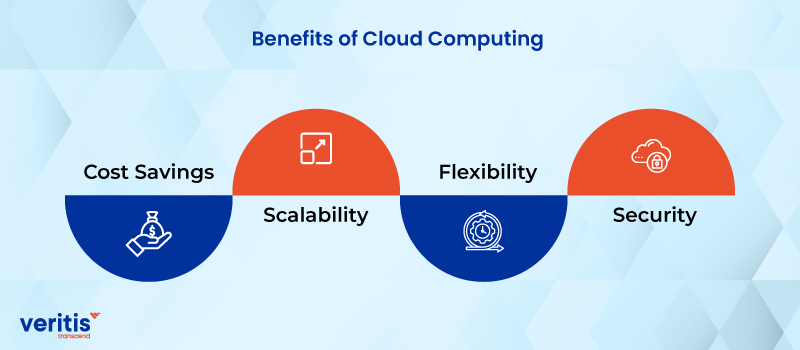
1) Cost Savings
Cloud computing offers substantial cost savings by adopting a pay-as-you-go model. Organizations only pay for the computing resources and services they use, eliminating the need for significant upfront investments in infrastructure. This cost-effective approach allows businesses to scale their operations efficiently, optimizing expenditure and promoting financial flexibility.
2) Scalability
The scalability of cloud computing is a game-changer for businesses. It allows companies to scale their IT infrastructure management resources up or down swiftly and seamlessly on demand. This flexibility ensures that companies can respond rapidly to changes in workload, whether handling increased traffic during peak periods or downsizing during quieter times. As a result, businesses can avoid over-provisioning and only allocate resources as needed, enhancing operational efficiency.
3) Flexibility
Cloud computing provides unparalleled flexibility, allowing organizations to deploy and manage applications and data from virtually any location with an internet connection. This flexibility benefits businesses with distributed teams or those looking to tap into global markets. Teams can collaborate in real-time across geographic boundaries, fostering innovation and enhancing overall productivity.
4) Security
Cloud providers prioritize security and invest heavily in advanced security features. Contrary to common misconceptions, many organizations find their data more secure in the cloud than when stored on-premise vs cloud. Cloud server infrastructure providers employ robust security measures, such as data encryption, multi-factor authentication, and regular security audits. Additionally, they often have dedicated teams of experts focused on monitoring and addressing security threats, providing protection that may surpass what individual organizations can achieve on their premises.
Benefits of On-premise Infrastructure
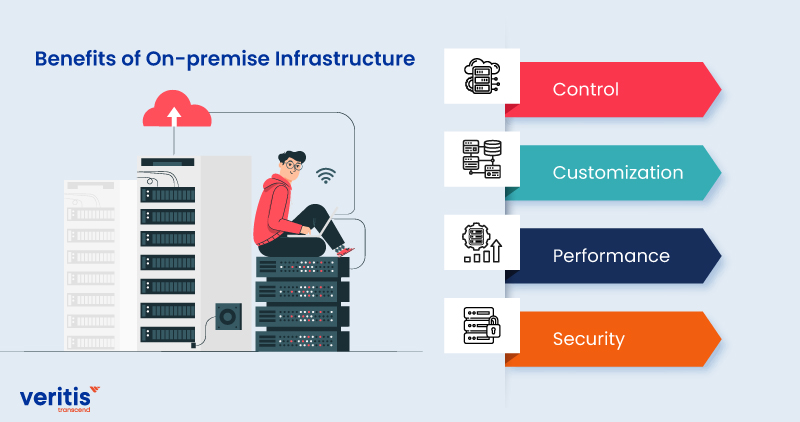
1) Control
On-premise infrastructure provides organizations with complete control over their IT infrastructure management environment. This level of control is crucial for specific industries, such as finance or healthcare, where regulatory compliance and data governance are paramount. Having physical control over servers, networks, and data centers allows organizations to implement specific policies and configurations tailored to their unique requirements. This control is precious when dealing with sensitive data that must adhere to strict regulatory standards.
2) Customization
On-premise infrastructure offers high customization to meet an organization’s specific needs. Businesses can design and implement infrastructure technology services tailored to their applications, workflows, and business processes. This level of customization is particularly beneficial for enterprises with specialized requirements or legacy systems that may not easily transition to a cloud IT infrastructure environment. It provides the flexibility to build and maintain infrastructure technology services precisely aligned with the organization’s objectives and technology stack.
3) Performance
On-premise infrastructure can deliver low-latency and high-performance access to data and applications. Since the infrastructure is physically located on-site, organizations can achieve optimal performance for applications that require real-time data processing or demand low-latency connectivity. This is especially important for industries such as manufacturing or research, where immediate access to data and rapid response times are critical for operational efficiency and competitiveness.
4) Security
Organizations can implement and manage their security measures on-premise vs cloud, offering a level of control that some businesses find preferable. This includes customizing security protocols, implementing stringent access controls, and monitoring the entire infrastructure in-house. For industries handling susceptible information or subject to stringent regulatory requirements, maintaining direct control over security measures provides a sense of assurance and compliance. Organizations can establish and enforce security policies tailored to their specific needs, addressing potential concerns related to data privacy and regulatory adherence.
Stuck at this point?
Answers to these questions lie in understanding key differentiators between the Cloud Vs On-premise models.
1) Hosting
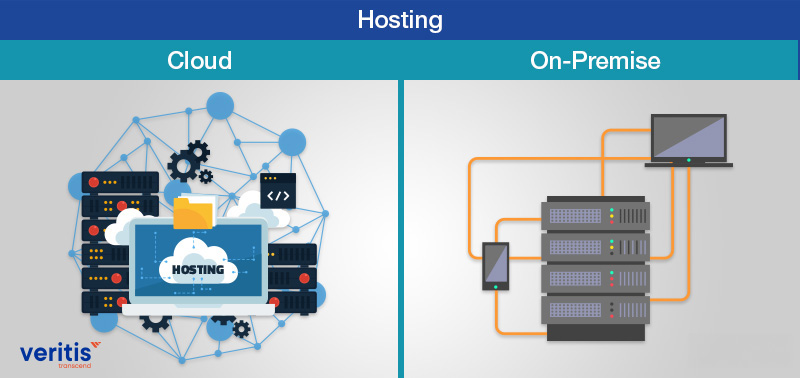
Hosting is the first factor that shows us a big difference between on-premise and Cloud infrastructure models.
As we see the on-premise servers, the infrastructure is maintained at the organization’s premises. This directly means the requirement of additional maintenance personnel for server management. Cloud IT infrastructure solutions work otherwise, and the Cloud infrastructure management is maintained over the network.
The cloud service providers (CSPs) in place will (by default) take care of the cloud computing environment. Be it upgrading software, addressing downtimes, repair, maintenance, or more pertaining to the accommodated public cloud computing servers.
Coming to sudden scenarios like server blackouts, Cloud solutions work their way with high scalability offerings.
| Key Factors | Cloud | On-Premise |
| Server Location | Third-party Cloud | Physical, On-premises |
| Maintenance | Off-site | On-site |
| Server Blackouts | Possible but Scalable | Possible |
| On-Demand | Easily Scalable | Consumes Time and Effort |
2) Deployment
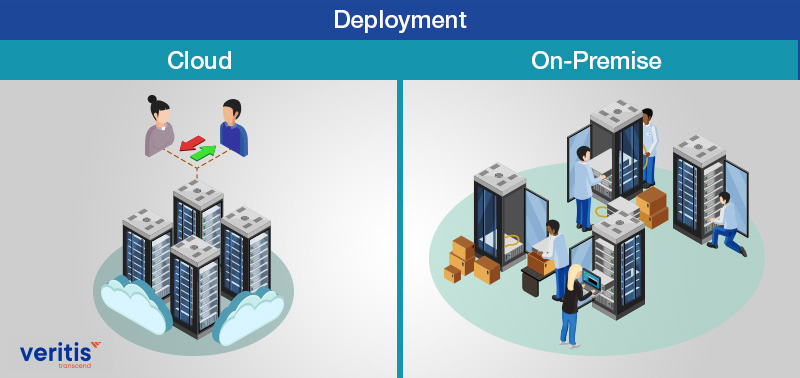
Having an on premise infrastructure server model means maintaining infrastructure on your own, which directly reflects in investment for servers, software, and technical personnel.
In that case, the entire risk at times of failure lies with the organization! Meanwhile, cloud computing infrastructure presents a safer perspective for your business. In Cloud solutions, any loss incurs only the subscription charges needed to utilize its virtual environment.
Cloud virtual infrastructure also offers you high flexibility in implementing broader infrastructure.
Cloud integration also facilitates faster installation and support services, while it might take days together to get an on-premise server on board. A system administrator with Cloud support can perform at a rate ten times faster than in an on-premise infrastructure.
| Key Factors | Cloud | On-Premise |
| Installation | Easy and fast | Time-consuming |
| Availability | On-demand | When bought and deployed |
| Investment | Less | High |
| Business Risks | Low | High |
3) Workflow and Delivery
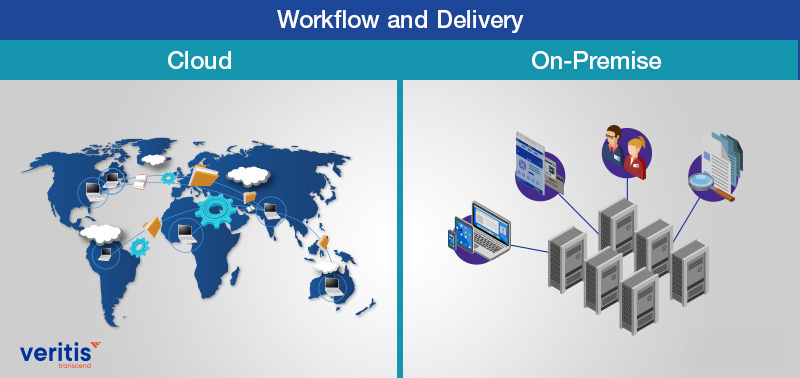
Straight answer to this Cloud!
Cloud is known for its ability to:
- Offer unlimited memory space
- Timely backup
- On-demand Cloud solutions availability
- Faster rate of application launch and release
- Timely software upgrades without the need for additional hardware in case of own datacenter
- Ability to handle IT infrastructure companies’ workloads
This might not be the case with an on-premise server. But testing and running workloads on the Cloud computing environment can be a temporary solution for those with on-premise infrastructure.
| Key Factors | Cloud | On-Premise |
| Unlimited Memory | Yes | No |
| Back-up | Timely | Effort-intensive |
| Rate of Application Launch and Deployment | High | Low |
| Ability to handling workloads | High | Low |
| Process Delivery | Smooth | Chances of interruption |
4) Energy Savings
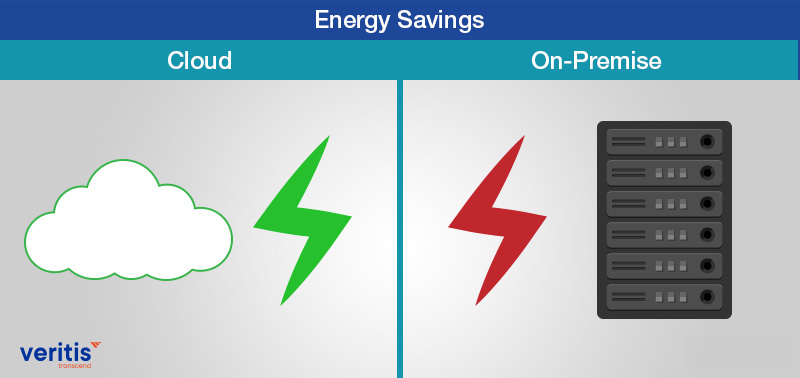
Considering the energy servers consume, on-premise server deployment involves more energy expenditure. While the servers consume 100 percent of their required power, managed on-premise servers demand 10-20 percent of the server’s power.
This naturally becomes a maintenance burden for organizations as they own the infrastructure and dream about energy savings. At the same time, the Cloud integration platform deals with this challenge as maintenance responsibility lies with service providers.
While energy consumption comes as part of a package in a Cloud service model, the on-premise model throws that burden on to the organization. Techniques like airflow management are being used to address the issue of heavy power consumption.
| Key Factors | Cloud | On-Premise |
| Energy Savings | Comes as part of a package | To be managed individually |
| Cost-Savings | High | Low |
| Scope for SMEs | High | Low |
| Scope for Corporates | High | Low |
| Maintenance Burden | Taken care of by CSP | Enterprise’s responsibility |
5) Bandwidth Enhancement
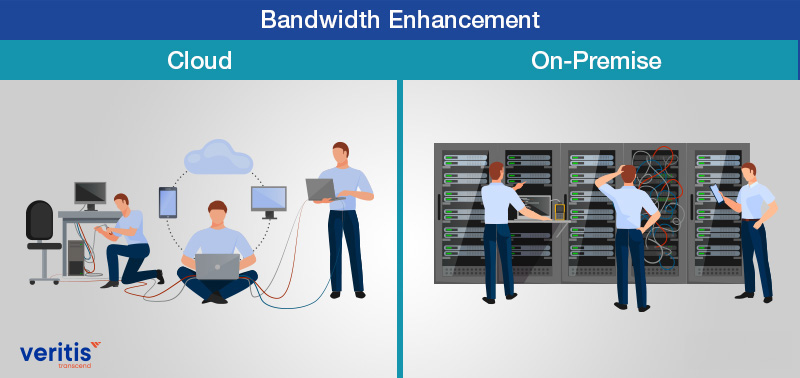
Cloud solutions allow enterprises to upgrade their requirements- memory, software, server space, etc. One can use virtual servers, virtual routers, and additional networks in the Cloud to enhance the size and capacities of existing storage.
All you have to do is upgrade your Cloud computing service models! This is not the case with on-premises infrastructure, where enhancement of bandwidth and capacity means physically deploying new servers.
However, one advantage that on-premises users can enjoy is ‘security’. Since you manage things physically with on-premises servers, you must make custom configurations per your organizational needs.
Cloud infrastructure fails here as the organizations only have to choose from the available options Cloud Service Providers (CSPs) provide.
| Key Factors | Cloud | On-Premise |
| Bandwidth Enhancement | On-demand | Demands new deployments |
| Hardware | CSP’s responsibility | Organization’s responsibility |
| Configurations | Standard | Customizable |
6) Access Control
Unexpected blackouts, malware, critical system failure, and technical issues are familiar to any system. But how you overcome the disaster is the real challenge. Cloud server infrastructure is a step ahead of the on-premises model.
Cloud solutions provide organizations with instant access to their virtual resources in case of disaster. With these features of cloud computing, you can backup, restore, and reboot software and data in a virtual environment.
Meanwhile, in on-premises vs. Cloud, the responsibility for security and privacy needs lies with the organization.
| Key Factors | Cloud | On-Premise |
| Malware Removal | Easy | Difficult |
| Vulnerability to Attacks | Yes | Yes |
| Responsibility of failure | CSP | Organization |
Choosing the Right Option
The right option for a company will depend on its specific needs and requirements. Some factors to consider include:
Industry: Some industries have regulatory requirements that may make cloud computing a more attractive option.
Application type: Some applications are better suited for cloud computing, while others are better suited for on premise infrastructure.
Budget: Cost is essential when picking between cloud computing and on premise infrastructure.
Security: Organizations must assess the security risks of cloud computing and on premise infrastructure.
Conclusion
The decision between Cloud and On-premise IT infrastructure models rests on critical considerations. On-premise entails capital expenditure, while Cloud offers operational cost advantages, allowing organizations to pay for actual usage and enhancing financial flexibility. Cloud’s distinct advantage lies in Disaster Recovery, facilitated by its adaptable application and data storage options. Security concerns are shared between both models, emphasizing the importance of context-specific decision-making. The key difference between on premise and cloud infrastructure lies in ownership and location, with on premise relying on in-house servers and hardware, while cloud utilizes remote servers accessed over the internet.
As a distinguished recipient of Stevie Awards and Globee Business Awards, Veritis, with a decade of expertise in Cloud solutions for a diverse range of firms, including Fortune 500 companies, stands ready to assist. Our tailored services ensure a seamless alignment of your IT strategy with organizational objectives. Choose Veritis for a reliable partner in navigating the dynamic field of cloud and on-premise IT infrastructure services, propelling your business towards efficient and strategic success.
Explore Cloud Services Got Questions? Schedule A Call
[WPSM_AC id=13727]
Additional Resources:
